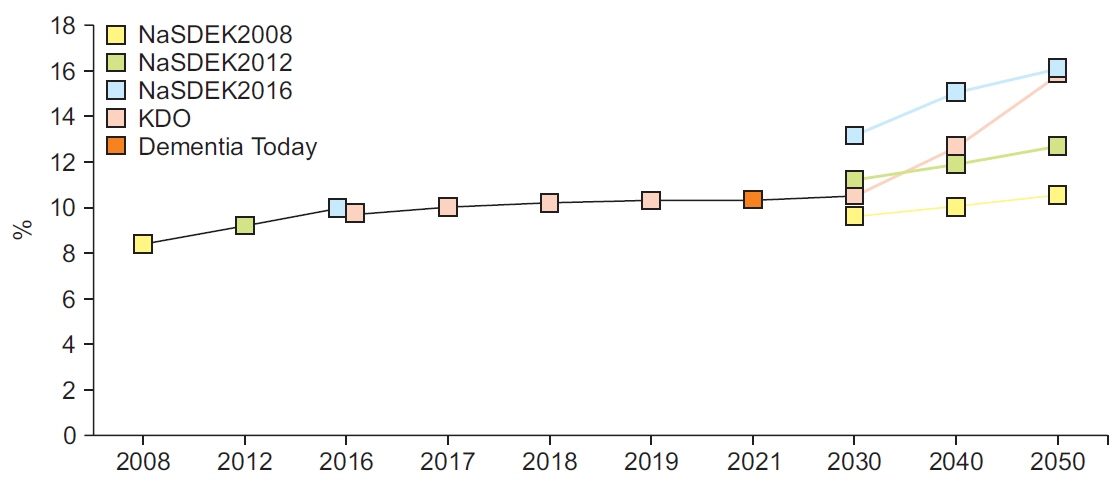Ann Rehabil Med.
2022 Apr;46(2):53-59. 10.5535/arm.22027.
Dementia Epidemiology Fact Sheet 2022
- Affiliations
-
- 1Department of Rehabilitation Medicine, National Rehabilitation Center, Seoul, Korea
- KMID: 2529506
- DOI: http://doi.org/10.5535/arm.22027
Abstract
- This dementia epidemiology fact sheet 2022 is aimed at providing an overview of the epidemiology of dementia in Korea using representative government-led data. This review summarizes the prevalence and incidence of this condition using various types of data. The prevalence and incidence of dementia have increased and are predicted to continue to do so. This information will be utilized by public health officials, healthcare professionals, and policymakers to develop strategies for dementia rehabilitation and prevention.
Keyword
Figure
Reference
-
1. Am Psychiatric Association. Diagnostic and statistical manual of mental disorders, fifth edition (DSM-5). Washington, DC: Am Psychiatric Association;2013.2. World Health Organization. Fact sheets of dementia [Internet]. Geneva, Switzerland: World Health Organization;2021. [cited 2022 Apr 13]. Available from: https:// www.who.int/news-room/fact-sheets/detail/dementia.3. Statistics Korea. 2021 Statistics on the aged [Internet]. Daejeon, Korea: Statistics Korea;2021. [cited 2022 Apr 13]. Available from: https://kostat.go.kr/portal/korea/ kor_nw/1/1/index.board?bmode=read&aSeq=403253.4. Shon C, Yoon H. Health-economic burden of dementia in South Korea. BMC Geriatr. 2021; 21:549.
Article5. Kim YJ, Han JW, So YS, Seo JY, Kim KY, Kim KW. Prevalence and trends of dementia in Korea: a systematic review and meta-analysis. J Korean Med Sci. 2014; 29:903–12.
Article6. National Institute of Dementia. Dementia today [Internet]. Seoul, Korea: National Institute of Dementia;2022. [cited 2022 Apr 13]. Available from: https://www. nid.or.kr/info/today_list.aspx.7. Kim KW, Suh SW, Kim YJ. An 8‐year comparison of dementia prevalence in Korea: results from the nationwide survey on dementia epidemiology of Korea, 2008 and 2016: epidemiology/prevalence, incidence, and outcomes of MCI and dementia. Alzheimers Dement. 2020; 16:e041839.8. Kim KW, Park JH, Kim MH, Kim MD, Kim BJ, Kim SK, et al. A nationwide survey on the prevalence of dementia and mild cognitive impairment in South Korea. J Alzheimers Dis. 2011; 23:281–91.
Article9. Ministry of Health and Welfare. 2012 nationwide survey on the dementia epidemiology of Korea. Seoul, Kore: Ministry of Health and Welfare;2012. p. 83–151.10. National Institute of Dementia. 2016 nationwide survey on the dementia epidemiology of Korea [Internet]. Seoul, Korea: National Institute of Dementia;2016. [cited 2022 Apr 13]. https://www.nid.or.kr/info/dataroom_ view.aspx?bid=182.11. Han JW, Kim TH, Jhoo JH, Park JH, Kim JL, Ryu SH, et al. A normative study of the Mini-Mental State Examination for Dementia Screening (MMSE-DS) and its short form(SMMSE-DS) in the Korean elderly. J Korean Geriatr Psychiatry. 2010; 14:27–37.12. Lee JH, Lee KU, Lee DY, Kim KW, Jhoo JH, Kim JH, et al. Development of the Korean version of the Consortium to Establish a Registry for Alzheimer’s Disease Assessment Packet (CERAD-K): clinical and neuropsychological assessment batteries. J Gerontol B Psychol Sci Soc Sci. 2002; 57:P47–53.
Article13. Morris JC. The clinical dementia rating (CDR): current version and. Young. 1991; 41:1588–92.14. American Psychiatric Association. Diagnostic and statistical manual of mental disorders, third edition (DSM-III). Washington, DC: American Psychiatric Association;1980.15. McKhann G, Drachman D, Folstein M, Katzman R, Price D, Stadlan EM. Clinical diagnosis of Alzheimer’s disease: report of the NINCDS-ADRDA Work Group under the auspices of Department of Health and Human Services Task Force on Alzheimer’s Disease. Neurology. 1984; 34:939–44.
Article16. Roman GC, Tatemichi TK, Erkinjuntti T, Cummings JL, Masdeu JC, Garcia JH, et al. Vascular dementia: diagnostic criteria for research studies: report of the NINDS-AIREN International Workshop. Neurology. 1993; 43:250–60.
Article17. Winblad B, Palmer K, Kivipelto M, Jelic V, Fratiglioni L, Wahlund LO, et al. Mild cognitive impairment : beyond controversies, towards a consensus: report of the International Working Group on Mild Cognitive Impairment. J Intern Med. 2004; 256:240–6.
Article18. Ohara T, Hata J, Yoshida D, Mukai N, Nagata M, Iwaki T, et al. Trends in dementia prevalence, incidence, and survival rate in a Japanese community. Neurology. 2017; 88:1925–32.
Article19. National Institute of Dementia. Korea Dementia Observatory 2020. Seoul, Korea: National Institute of Dementia;2021.20. National Institute of Dementia. Korea Dementia Observatory 2017. Seoul, Korea: National Institute of Dementia;2017.21. National Institute of Dementia. Korea Dementia Observatory 2018. Seoul, Korea: National Institute of Dementia;2018.22. National Institute of Dementia. Korea Dementia Observatory 2019. Seoul, Korea: National Institute of Dementia;2020.23. Seong SC, Kim YY, Khang YH, Park JH, Kang HJ, Lee H, et al. Data Resource Profile: The National Health Information Database of the National Health Insurance Service in South Korea. Int J Epidemiol. 2017; 46:799–800.24. Health Insurance Review and Assessment Service. Analysis of medical use of dementia patients. Wonju, Korea: Health Insurance Review and Assessment Service;2018.25. National Evidence-based Healthcare Collaborating Agency. Development of a methodology for estimating financial needs related to dementia. Seoul, Korea: National Evidence-based Healthcare Collaborating Agency;2017.26. Bae JB, Kim YJ, Han JW, Kim TH, Park JH, Lee SB, et al. Incidence of and risk factors for Alzheimer’s disease and mild cognitive impairment in Korean elderly. Dement Geriatr Cogn Disord. 2015; 39:105–15.
Article27. Jang JW, Park JH, Kim S, Lee SH, Lee SH, Kim YJ. Prevalence and incidence of dementia in South Korea: a nationwide analysis of the National Health Insurance Service Senior Cohort. J Clin Neurol. 2021; 17:249–56.
Article28. Kim YI, Kim YY, Yoon JL, Won CW, Ha S, Cho KD, et al. Cohort Profile: National health insurance servicesenior (NHIS-senior) cohort in Korea. BMJ Open. 2019; 9:e024344.
Article29. Wu YT, Beiser AS, Breteler MM, Fratiglioni L, Helmer C, Hendrie HC, et al. The changing prevalence and incidence of dementia over time - current evidence. Nat Rev Neurol. 2017; 13:327–39.
Article
- Full Text Links
- Actions
-
Cited
- CITED
-
- Close
- Share
- Similar articles
-
- Prevalence and Current Management of Cardiovascular Risk Factors in Korean Adults Based on Fact Sheets
- Epidemiology of Vascular Dementia
- Correction: Stroke Rehabilitation Fact Sheet in Korea
- Association of nonalcoholic fatty liver disease with incident dementia later in life among elderly adults
- Differential Diagnosis of Vascular Dementia and Alzheimer's Disease



